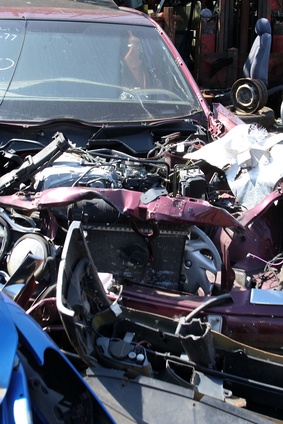
Urethane primer is commonly used in body shops as a surface coat that provides a sealed, protective base on auto panels prior to painting. It possesses a high solid content that is superior to lacquer primer alternatives and creates additional build-up during the spraying process. When it is subsequently rubbed down, urethane primer leaves a flat, even finish that withstands corrosion, fills scratch marks in body filler and provides an etched surface to promote paint adhesion. When using the correct preparation techniques, urethane primer is an excellent surface material that is suitable for all body shop applications.
Smooth all applications of body filler on the repaired auto body panels to a P180-grit finish to minimize scratch marks. Take a random orbital sander with a P320-grit sanding disc and feather out the paint edges until a completely flat surface is achieved. Sand the rest of the panel with a P500-grit sanding disc, taking care not to scuff adjacent panels. This will provide a keyed surface for the urethane primer to stick to.
Clear dust from the panel with an air blower and wipe clean with a piece of cloth soaked in degreaser. Isolate the prepared auto body panel by masking it up with tape and paper to prevent over-spray. Wipe over the surface of the panel with a tack cloth to remove any remaining traces of dust and debris. Activate the urethane primer with a compatible hardener using the ratio provided on the technical data sheet. Usually, high solid urethane primers are mixed at a ratio of three parts primer to one part hardener. Stir thoroughly and transfer the material to a spray gun with a 1.6 mm fluid tip set-up.
Plug the spray gun into an airline and apply three full coats of activated primer, leaving a 10-minute curing period between each coat. Pay particular attention to material build-up over repairs. Once the last coat of primer has been applied, clean out the spray gun with cellulose thinners and leave the primer to dry overnight. Alternatively, urethane primer can be force dried in a paint oven for 30 minutes at 160 degrees Fahrenheit.
Apply a light coat of matte black paint over the dry primer to create a guide for rubbing down and leave to dry for five minutes. Take a sheet of P800-grit wet-and-dry paper and wrap it around a rubber sanding block. Immerse the block and paper in clean water and transfer to the primed auto body panel with the large, flat area of the block resting over the repairs. Move the arm backwards and forwards over the primer. The black guide coat will rub away as the build of the urethane primer is reduced to highlight scratches and uneven areas.
Continue rubbing down, adding more water when required, until the guide coat has been completely removed and the panel is left with a flat, even surface. Dry the vehicle with cloth and remove all old masking. Degrease the panel to remove all traces of primer remnants and apply clean tape and masking paper. The surface of the auto body panel is now fully prepared and can be wiped with a tack cloth prior to painting.